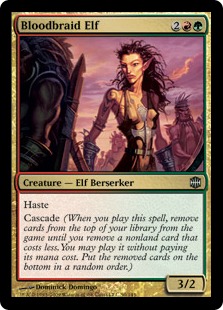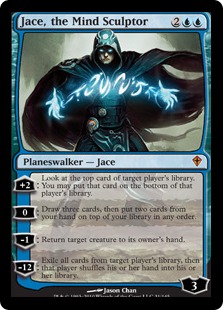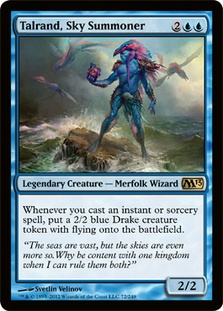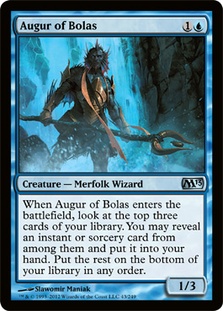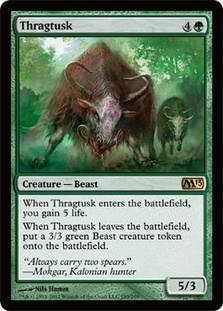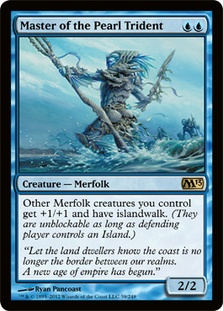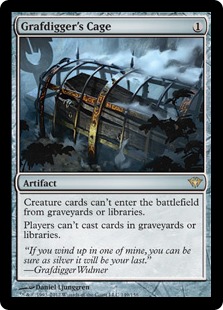I’m not usually one to get excited about the release of a new set. By the time a format is ready for a new set to enter the spotlight, I’ve usually found a deck that I’m comfortable with, preferably with a hefty dose of blue cards, and I’ve tuned it to the point that I don’t fear anything going into a tournament. Core sets are frequently especially unexciting for me since the mechanics and cards usually don’t lend themselves to new archetypes and major metagame shifts; rather, they bolster existing archetypes and tweak the metagame balance.
This pattern of being unimpressed with new sets has repeated itself for a while, probably since around 2009 and the printing of Bloodbraid Elf. I was happy to be playing B/W Tokens, and when the Elf got printed, I thought that everyone was overreacting about how good the card was. After all, Windbrisk Heights and Spectral Procession was still the most powerful thing in the format, and even though these new-fangled Jund decks gained Maelstrom Pulse and Bloodbraid Elf, it didn’t worry me. How could they hope to beat my string of bombs like Bitterblossom, Spectral Procession, Cloudgoat Ranger, and Ajani Goldmane?
Well, as it turned out, there was this new deck that took cascade to its logical extreme, and it just so happens that Swans of Bryn Argoll didn’t care about Spectral Procession and Cloudgoat Ranger. Cascade broke B/W Tokens’ stranglehold on the format, and it was all thanks to that pesky 3/2 with haste. I had to patiently wait out the rotation with a deck that suddenly had bad matchups, and, of course, I picked up Jund as soon as it became the big dog in the house.
It happened again with the printing of the best card this side of Ancestral Recall: my old friend Jace. You may not believe this, but I was quite infatuated with Bloodbraid Elf by early 2010. I thought, "Who cares about this planeswalker? I’m just going to Blightning them and win easily. Bloodbraid Elf stacks up so well against Jace, as does the rest of Jund." I couldn’t imagine a Jace deck being any good in a Bloodbraid format. But then Eldrazi Conscription was printed, and suddenly all of the pieces came together for me to play Mythic Conscription. I immediately dumped Bloodbraid for Jace, changing my opinion on the card faster than Mitt Romney changed his opinion about public healthcare.
And it was good. I played Mythic to a PTQ win, and I felt I could do no wrong with the deck. Then Primeval Titan was printed that summer, and people started talking about Valakut as the new powerhouse on the block. I couldn’t believe it. Primeval Titan was just so much worse than Sovereigns of Lost Alara as a game-ender, and my deck could counter his Titan with the newly printed Mana Leak! I was again infatuated with my old cards to the exclusion of new possibilities. I laughed at Primeval Titan decks as "little kid" decks, stuck with my guns, and though I still did well, I started noticing that I was always behind on the new technology.
In fact, I simply take a while to come around on a new card or deck. Call me skeptical, but I need to see results before I believe in a new deck when I already have one I love playing.
One more example: let’s think about Delver for a second. You know, that broken card in that totally unfair deck that’s been wreaking havoc on Standard for the last six months. Remember when it started with Todd Anderson playing it as a less-consistent Phantasmal Bear at the release of Innistrad? I laughed at the deck, as I’m sure many of you did. But it kept improving, and around the time of Worlds last year and the StarCityGames.com Invitational in Charlotte, it became one of the best, most popular decks in the format. Why did it take so long for us to recognize the power in this aggro-control deck? I know that for me personally, it’s a lack of creativity and a closed, dogmatic mindset about what’s good in a given format.
There are benefits to this skeptical mentality, especially in more static formats like Legacy, but in dynamic formats like Standard, it’s a bit of a hindrance. I’m consciously going to try to change that with this set.
I can see it already, with my almost immediate dismissal of Talrand and Augur of Bolas in Delver even though others like Adam Prosak have picked those cards up to great success.
Creatures (16)
Lands (18)
Spells (26)
- 2 Mana Leak
- 4 Ponder
- 1 Sword of Feast and Famine
- 2 Mutagenic Growth
- 2 Mental Misstep
- 1 Sword of War and Peace
- 4 Gitaxian Probe
- 4 Vapor Snag
- 2 Gut Shot
- 4 Thought Scour
Sideboard

My immediate reaction upon seeing this decklist was, of course, dismissive. Why would I play clearly less powerful cards like Augur of Bolas and Talrand, Sky Summoner when I can have Blade Splicer and Restoration Angel? If Delver is an aggro-control deck, it wants creatures that can play defense and beat down, which is exactly what Angel-Splicer offers you.
Augur is pretty anemic on the beatdown front and doesn’t even defend as well as a 3/3 first-striking Golem token. And Talrand requires you to immediately play other cards to even start approaching the value that a 3/4 flash flyer gives you. What I see here is a deck that has given up its ability to play an effective control game and simply must get either an early tempo lead or stick a Talrand and a couple of instants or sorceries to actually win. Why would I want a deck that can’t effectively turn the tempo on an opponent in the midgame without a specific, fragile three-of? In short, this deck is just inferior to classic Angel Delver.
But that’s the old Ben. I’m going to try to balance out my critiques with a healthy dose of optimism about this list. Where to begin?
Well, to start, this list plays 24 instants and sorceries including twelve cantrips, which increases Delver’s and Augur’s hit percentages. It also means that the Talrand is going to come up more often than you’d expect from a three-of. I assume that there was a fair number of Adam’s turn 4s that went something like Talrand, Gitaxian Probe, Gut Shot, which is certainly better than Emeria Angel’s ability in Caw-Blade. With such a cantrip density, you can sculpt your Talrand turn pretty well and turn him into three 2/2s for four mana.
From there, the game is pretty academic. Obviously, this takes a little more work than Splicer-Angel, but the potential ceiling of a Talrand makes me drool. I could easily see making five 2/2s in a single turn considering how cheap and plentiful these instants and sorceries are. Restoration Angel may be more functional and flexible, but Talrand will win you games if you build your deck to maximize him.
One issue I have with Talrand as a centerpiece is that he’s so Mana Leakable in the semi-mirror. Look at that four-mana sorcery speed spell and tell me that you expect to resolve him in your deck without Cavern of Souls. He’s just such a lightning rod for countermagic and removal that I have doubts about his ability to dominate the format.
Another issue I have is the lack of Runechanter’s Pike. This deck is likely to make it a bigger boost than any other in the format, yet this list eschews the Pike for a pair of mismatched Swords. That seems sketchy to me, although it obviously worked for Mr. Prosak.
But I digress into negativity. Augur of Bolas, if you design your deck right, is damn near a two-mana Court Hussar. That’s a pretty good card, although creatures are doing more and more nowadays so comparing Augur to a card that was playable six years ago is not always useful. In a Talrand deck, of course, the Augur gives you additional potential Talrand triggers as well as digs for good ways to protect your Talrand. Its body isn’t huge by any means, but it’s a great candidate to hold a Runechanter’s Pike or a Sword. It also lowers the mana curve, and by finding cantrips it smooths out your draws so you are even more likely to find the cards you need when you need them.
This eighteen-land deck functions like a 24-land deck when you consider how many ways it has to dig while still allowing it to draw gas most turns in the mid to late game. This is a characteristic of every Delver deck, of course, but it is amplified in this particular build. That additional amount of draw smoothing might make up for the slightly higher variance Talrand and provides him with the perfect environment to maximize his ability. Free 2/2 flyers are no joke, and this is one of the only times I think Talrand is going to be able to shine, so I’m willing to take a chance on him before dismissing him.
Now, there’s also this Naya Pod deck that seems to be pushing our beloved blue spells off of the throne in Standard, and it incorporates another sweet five-drop to complement Zealous Conscripts: Thragtusk. Caleb Durward played a copy in his deck that won the SCG Standard Open in St. Louis since it’s one of the better value targets for Birthing Pod and a great stop sign for many aggressive starts.
This is a card that is going to be played heavily during its tenure in Standard, mainly because Restoration Angel is just such great pals with it aside from them both being solid on their own. My only criticism of the card is how well Blade Splicer tokens stack up against it, as well as how an opposing Restoration Angel doesn’t care about it very much when the Angel is getting aggressive. Still, for a fat green creature, this is about as good as it gets against a card like Vapor Snag.
As for Modern and Legacy, there’s really only one card I see making waves, and that is the new Lord of Atlantis: Master of the Pearl Trident. Now that Merfolk decks have gained another member in a long line of Lords, they may have the boost they need to succeed in both formats. The ‘Folk are on the rise in Legacy, and although the list from the last SCG Legacy Open is clearly constrained by budgetary concerns, I wouldn’t be surprised to see the fishies bringing down some more tournaments soon. After all, they just won the Legacy Open in Seattle, and that was even before we got the new Lord. From this recent winning list, I’d make a few changes to adapt to the new set.
Creatures (24)
- 1 Kira, Great Glass-Spinner
- 4 Lord of Atlantis
- 4 Merrow Reejerey
- 4 Silvergill Adept
- 1 Sower of Temptation
- 4 Cursecatcher
- 4 Coralhelm Commander
- 2 Phantasmal Image
Lands (20)
Spells (16)

I’d be interested in cutting Sower, two Reejerey, and a Kira for the four Lords, and I’d change that sideboard around to have the second Kira, another Dismember, and a pair of Virtue’s Ruin instead of the Dread of Night, the two Pithing Needles (I hate that card), and a Submerge (Dismember fills that role reasonably well). I wouldn’t mind having a pair of Spell Pierces instead of the Hydroblasts as well. It just seems like a more widely applicable card and is almost as good in the spots where you want Hydroblast.
Merfolk might get some derision from experienced Legacy players since it hasn’t been good for a while, but it’s no joke. Now that you can overload your opponent with Islandwalking Lords, even the best control and aggro-control blue decks will have a hard time stopping you from stealing wins.
Unfortunately, Legacy is such a powerful format where decks have a long time to develop that it’s hard for new cards to break in. Aside from a single Yeva maybe making it in Elves, I don’t see the format being changed much by M13.
Modern, though, is a different story. The format is still pretty new, and since no one has really proven what’s good in it yet, there’s a lot of room for innovation and for new cards to shake up the status quo (see: Restoration Angel in Naya Pod).
Merfolk in Modern is a realistic goal, although with fewer blue decks to prey on, it’s naturally going to be harder to make a good Merfolk list. I’d start with:
Creatures (27)
- 2 Kira, Great Glass-Spinner
- 4 Lord of Atlantis
- 3 Merrow Reejerey
- 4 Silvergill Adept
- 4 Cursecatcher
- 3 Coralhelm Commander
- 3 Phantasmal Image
- 4 Master of the Pearl Trident
Lands (20)
Spells (13)
Sideboard

This list is obviously quite rough around the edges, but I think it’s close to where you want to be in this format. Depending on the number of Pyroclasm type effects you expect, you might want to remove Kira for more countermagic. I’d consider putting her in the board and maindecking two Leaks. Kitchen Finks could also become Leyline of Sanctity if that’s more your type of card.
As for additional thoughts on the Modern GP coming up, my instinct is that the tournament is going to end up with Delver-based tempo decks versus Pod-based combo decks as the key common matchup on Day 2. If you are prepared to beat the Delver variants and the Naya/Melira Pod decks, you are poised to go deep in the tournament. Grafdigger’s Cage seems like it’s finally getting the recognition it deserves as an excellent hate card against Pod, and I wouldn’t be surprised to see it as the most played sideboard card on Day 2. If you’re planning on playing Birthing Pod, good for you! Prepare a sideboard strategy that has answers to Cage, because your opponents will have it.
If you’re playing a Delver-based deck, good for you! Prepare to grind out those semi-mirrors. Have a trump of some kind because it’s going to end up looking like the Standard Delver mirrors where as long as you keep pace with your opponent each step of the game, you’re going to end up staring each other down around turn 10. The Swords of War and Peace or Consecrated Sphinx or Sun Titan end games are what really matter. Planeswalkers are late game trumps; so is Vedalken Shackles. Have answers to those cards.
If you’re playing Storm or Twin, good for you! Make sure to play Pyroclasm (or Grim Lavamancer if you’re Twin) since you’re going to be facing down Thalia, Ethersworn Canonist, Delver of Secrets, Steppe Lynx, Geist of Saint Traft, and Vendilion Clique more than you’d like. Having a cheap answer that also doubles as a great Time Walk in the early game is exactly what you want.
If you’re playing something else, good for you! It might not be as on the radar as the aforementioned archetypes, but this is the perfect GP to go rogue.
And if you’re playing Affinity, boo you! Your deck is no fun to play against! But good luck anyway; I just hope I don’t have to play you.
See you in Columbus!
Best wishes,
Ben Friedman

